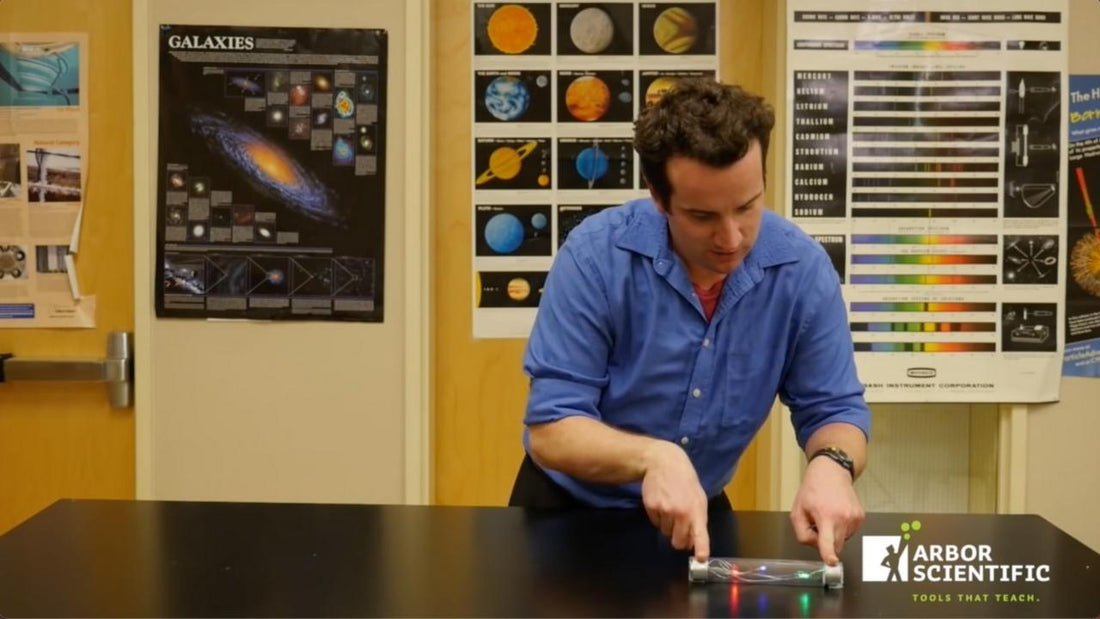Featured Products
Fun and engaging activities using the Energy Stick
In this CoolStuff Insider Blog we are featuring a simple, safe and Cool device called an Energy Stick. Physics teacher James Lincoln demonstrates several experiments that help students understand the principles of electric current and light. James has authored many of our past CoolStuff Newsletters, and teachers have really enjoyed his insight, passion and creativity. We encourage you to let us know what you think, and please feel free to contribute to the conversation by submitting a comment. Thank you for being a CoolStuff subscriber – enjoy!
The Energy Stick is a fun and easy way to demonstrate many of the principles of electric current and light. These topics are important for both the physics and the chemistry teacher. In this article, I will outline several of these such experiments including new ones not seen anywhere else.
1) GETTING STARTED
To operate the Energy Stick, make bodily contact with both ends of it. This sends a microcurrent through your body which is amplified by the circuit inside and sent to the LEDs and speakers inside. This is how you can know whether a measurable electric current is able to flow from one side of the stick to the other.
2) CONDUCTIVITY OF VAROUS OBJECTS
One of the first experiments you will want to do with the Energy Stick is check what other objects conduct electricity. This is a good lesson in the properties of metals for chemistry, physics, or middle school science. You will find that mostly metals conduct electricity. I have also found that even distilled water conducts electricity well enough to have an effect. This should not be a surprise since the human body is mostly water and the human body works well.
Miscellaneous household items are good candidates for conductivity tests.
The open circuit fails to light
Closing hands completes the loop and current can flow
3)THE IDEA OF A COMPLETE CIRCUIT
An important lesson is that for current to flow the circuit must complete a closed loop. Thus, if there is a break anywhere in the circuit electricity cannot move through any part. This can be dramatically demonstrated by having several members of the class join hands in a ring and complete a very large circuit.
The Energy Stick's Voltage is only about 30 milliVolts. The current output depends on the circuit it is connected through but is always only a few milliamps at most.
4) INVESTIGATIONS OF THE CURRENT
Connecting the two ends of the Energy Stick with a wire activates the circuitry inside. You can connect that wire to other electric devices such as a ammeter and voltmeter. In both cases the measurements will be quite small so it helps to have sensitive meters. The Energy Stick is a safe way to familiarize students with these probes.
5) THE PLASMA GLOBE and the Frequency of Light
A plasma globe can also be used to turn on the circuitry of the Energy Stick. Since the circuit inside amplifies very small currents, the electric field near the plasma is enough to get an effect. Inside the Energy Stick the red, green, and blue diodes turn on at different distances. This is a lesson in modern physics and chemistry. That is the meaning of the formula E=hf.
The Red Diode is the first to turn on.
As the Energy Stick is brought nearer the plasma globe, the other colors turn on. Next green, then blue last.
Red light having a lower frequency (longer wavelength) than blue and green light will can be produced at a lower voltage (energy/electric charge). Therefore, the blue diode is the last one turn on. This recalls the idea of the photoelectric effect that it is not the brightness of the light but its frequency that determines how energetic it is.
James Lincoln
Tarbut V' Torah High School, Irvine, CA USA
James Lincoln teaches Physics in Southern California and has won several science video contests and worked on various projects in the past few years. James has consulted on TV's "The Big Bang Theory" and WebTV's "This vs. That" and the UCLA Physics Video Project.
Contact: James@PhysicsVideos.net


